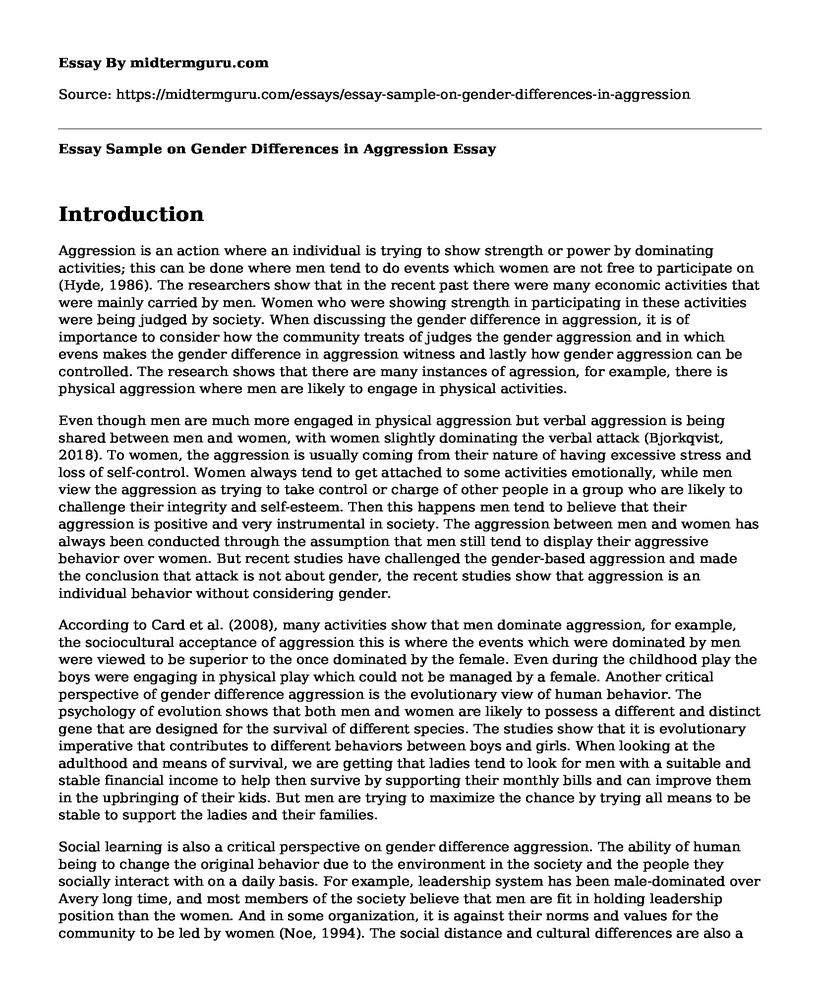Introduction
Aggression is an action where an individual is trying to show strength or power by dominating activities; this can be done where men tend to do events which women are not free to participate on (Hyde, 1986). The researchers show that in the recent past there were many economic activities that were mainly carried by men. Women who were showing strength in participating in these activities were being judged by society. When discussing the gender difference in aggression, it is of importance to consider how the community treats of judges the gender aggression and in which evens makes the gender difference in aggression witness and lastly how gender aggression can be controlled. The research shows that there are many instances of agression, for example, there is physical aggression where men are likely to engage in physical activities.
Even though men are much more engaged in physical aggression but verbal aggression is being shared between men and women, with women slightly dominating the verbal attack (Bjorkqvist, 2018). To women, the aggression is usually coming from their nature of having excessive stress and loss of self-control. Women always tend to get attached to some activities emotionally, while men view the aggression as trying to take control or charge of other people in a group who are likely to challenge their integrity and self-esteem. Then this happens men tend to believe that their aggression is positive and very instrumental in society. The aggression between men and women has always been conducted through the assumption that men still tend to display their aggressive behavior over women. But recent studies have challenged the gender-based aggression and made the conclusion that attack is not about gender, the recent studies show that aggression is an individual behavior without considering gender.
According to Card et al. (2008), many activities show that men dominate aggression, for example, the sociocultural acceptance of aggression this is where the events which were dominated by men were viewed to be superior to the once dominated by the female. Even during the childhood play the boys were engaging in physical play which could not be managed by a female. Another critical perspective of gender difference aggression is the evolutionary view of human behavior. The psychology of evolution shows that both men and women are likely to possess a different and distinct gene that are designed for the survival of different species. The studies show that it is evolutionary imperative that contributes to different behaviors between boys and girls. When looking at the adulthood and means of survival, we are getting that ladies tend to look for men with a suitable and stable financial income to help then survive by supporting their monthly bills and can improve them in the upbringing of their kids. But men are trying to maximize the chance by trying all means to be stable to support the ladies and their families.
Social learning is also a critical perspective on gender difference aggression. The ability of human being to change the original behavior due to the environment in the society and the people they socially interact with on a daily basis. For example, leadership system has been male-dominated over Avery long time, and most members of the society believe that men are fit in holding leadership position than the women. And in some organization, it is against their norms and values for the community to be led by women (Noe, 1994). The social distance and cultural differences are also a critical perspective of gender aggression the study of the difference between men and women in society in the main social zones of interaction. The social distance is where the society views and suggests that there is a difference between men and women in society according to the roles and responsibility they play.
Conclusion
In conclusion, I believe that the sociocultural perspective clearly explains the gender difference aggression. This because in the society today difference communities have their own beliefs on the gender differences and which are passed from one generation to another. The cultural beliefs define the gender roles in the society, and the functions which are identified are being moved from age to another. The three assumptions in the community include the difference in the social structure of childhood playgroups whereby girls always tend to have smaller playing groups compared to boys. A different generation ever adopts this observation in society. Another assumption in the community today is that the greater intimacy of female in the social patterns always leads to more well-known sharing personality in the future. The last assumption is that the relative physical strength of boys and girls determine their success in the future. These assumptions in most occasions might not apply in real life situation. It is essential for the member of the society to fight against gender aggression.
References
Bjorkqvist, K. (2018). Gender differences in aggression. Current Opinion in Psychology, 19, 39-42.
Hyde, J. S. (1986). Gender differences in aggression. The psychology of gender: Advances through meta-analysis, 51-66.
Card, N. A., Stucky, B. D., Sawalani, G. M., & Little, T. D. (2008). Direct and indirect aggression during childhood and adolescence: A metaanalytic review of gender differences, intercorrelations, and relations to maladjustment. Child development, 79(5), 1185-1229.
Noe, S. R. (1994). Gender differences in aggression.
Cite this page
Essay Sample on Gender Differences in Aggression. (2022, Oct 05). Retrieved from https://midtermguru.com/essays/essay-sample-on-gender-differences-in-aggression
If you are the original author of this essay and no longer wish to have it published on the midtermguru.com website, please click below to request its removal:
- Interpersonal Relationships: Love Styles
- Essay on Challenges of Older Adults Experience in Managing Their Health
- Paper Example on Crisis and Trauma Counseling
- Essay Sample on Group Psychotherapy
- Psychology of Emotion, Motivation & Stress: Impact on Humans - Essay Sample
- Nutrient Deficiencies & Eating Disorders: A Biochemical Imbalance? - Essay Sample
- ADHD in Kids: Struggles With Processing Information - Essay Sample







